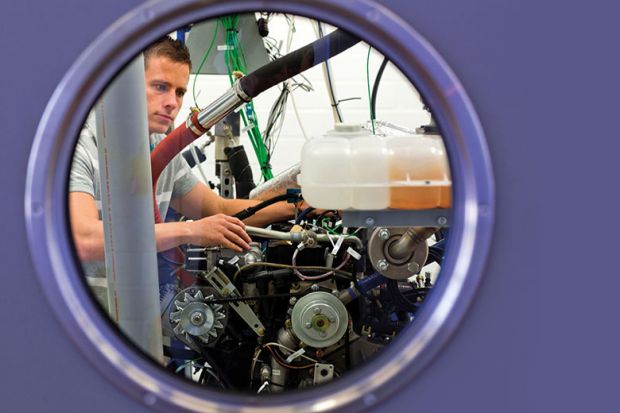The Venezuelan economy is in free fall. A drop in oil prices and a collapse in confidence in the country’s leadership have caused the economy of the once affluent South American country to contract by 50 per cent since 2013, according to the International Monetary Fund, and inflation to hit 13,000 per cent.
The country’s universities have by no means been spared the pain. Amalio Belmonte, rector of the Central University of Venezuela, recently said that he was encouraging academics to get second jobs to help them make ends meet. The university is also one of a number in the country planning to move to a three-day week, having received only a third of its expected budget for this academic year. Not surprisingly, then, a major brain drain is under way, encompassing both academics and students.
While the extremity of the Venezuelan crisis is unusual, the lack of protection afforded to its higher education sector in times of austerity is not. The economic crisis of 2008 saw many countries slash their spending on universities and research; the UK was unusual in largely maintaining budgets by converting most of the teaching grant into student loans.
The logic to the UK’s approach – loudly trumpeted by the universities themselves – was that since higher education and research are crucial to economic growth, those are the last sectors that should be cut when the economy takes a turn for the worse. This is an argument that is very commonly voiced in developed, “knowledge” economies – as well as those that aspire to that status. And it makes great intuitive sense: universities produce advances in knowledge and the educated workers necessary to capitalise on them. Global University rankings are dominated by universities from wealthy countries in the West and East Asia. Some institutions, indeed, have links to specific industries, such as Stanford University with Silicon Valley, and the Korea Advanced Institute of Science and Technology (KAIST) with Samsung.
Of course, some highly developed nations, such as Japan, Spain and Italy, are conspicuous by their under-representation in university rankings. But even if these countries generally lack institutions that hit the international heights, all three have highly developed university systems.
Analysis by Times Higher Education suggests that research quality (measured by field-weighted citation impact: an assessment of citation volume that takes account of yearly and disciplinary fluctuations) correlates quite strongly with factors such as gross national income (GNI) per capita and the United Nations’ human development index, which takes into account both economic and social factors. At least, it does if you confine the analysis to countries that produce significant volumes of research: smaller nations – many of which have anomalous citation statistics – make the correlation much weaker, or even negative.

According to Simon Marginson, professor of international higher education strategy at the UCL Institute of Education, this is because some countries “don’t have developed research systems, meaning that the relationship [between GNI and citation impact] is not tested. Research capacity is distributed in a non-linear fashion. The problem with statistical measures is that they assume linear distributions in a non-linear world”.
Research productivity – measured by number of papers produced per head of population – also correlates reasonably strongly with economic development measures. So do enrolment levels in tertiary education – although, interestingly, the correlation declines as enrolment rates increase, suggesting that a law of diminishing returns could apply.
In addition, according to Anna Valero, an ESRC innovation fellow at the London School of Economics, “simple country-level correlations show that those with more universities tend to have more patents. And [evidence suggests links between] local patenting and growth. These effects tend to be stronger for growth in industries that are relevant for the particular patent or research area”.
But even if there are correlations between economic development, tertiary enrolment, research quality and patenting activity, does that imply causal links between them? And, if so, which way does the causality flow?
Some commentators are sceptical of the idea that universities are the cause of economic development, as opposed to being a result of it. In a recent edition of THE, Lincoln Allison, emeritus reader in politics at the University of Warwick, wrote: “Of course, Sweden is much richer than Burundi and has many more people in higher education, but the causal process is largely the other way round” (“My learned friends”, Features, 8 March). In defence of his view, he cites the example of Switzerland: a highly developed country that, by international standards, sends relatively few people to university: just under 28 per cent of under-25s at the most recent count (“No more graduates needed: Switzerland takes its own route”, News, 26 April).
But, of course, Switzerland does have a very strong university research sector. And there is some evidence to suggest that developing higher education has some causal effect on the development of an economy – especially at a local level. In their 2016 discussion paper, “The Economic Impact of Universities: Evidence from Across the Globe”, Valero and her LSE colleague John Van Reenen estimate that a 10 per cent increase in a region’s number of universities per capita equates, on average, to 0.4 per cent growth in its future GDP per capita.
But the effect is weaker for regions with higher GDP per capita relative to the “frontier” region in that country, Valero explains. The effect is also stronger for regions with fewer universities to begin with; adding one university to a region that has only one existing university would lead to a 3 per cent boost in GDP, while adding a university to a region that already has 100 universities would result in a boost of only 0.04 per cent, Valero says. This suggests that universities could play a particularly crucial role in the earlier stages of regional economic development.
Measure for measure: how higher education shapes wealth and human development
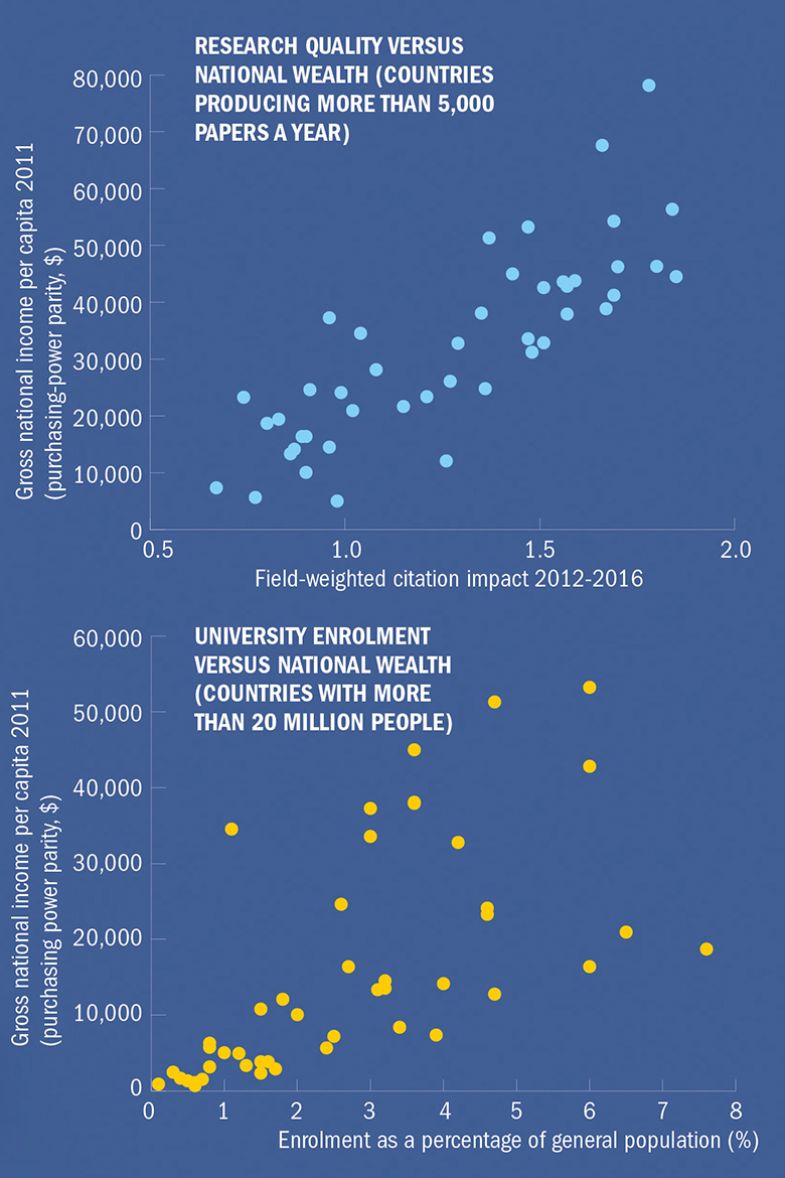
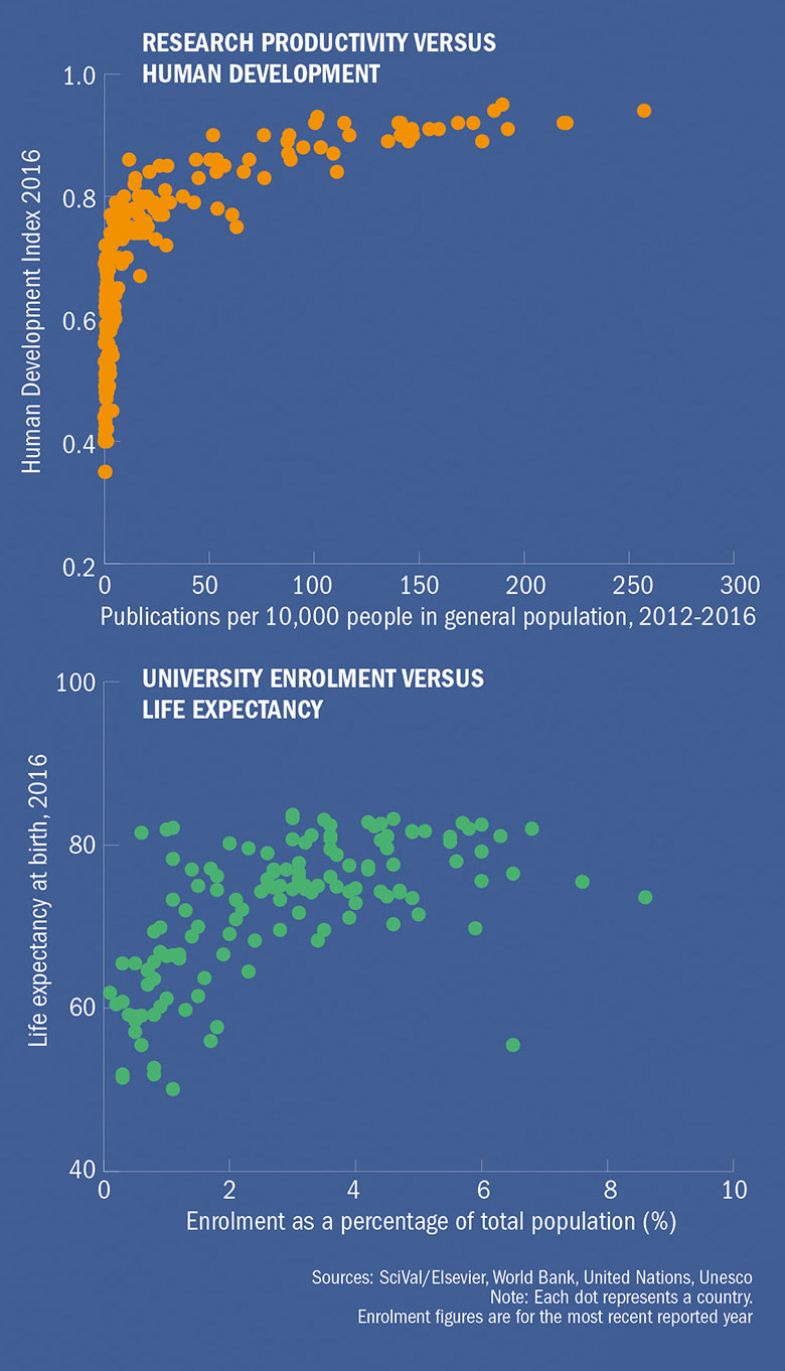
But Valero and Van Reenen also note that seven countries (including Mexico, Brazil and India) account for more than half of the world’s universities. Why, then, are those countries not all world-leading economies? According to Valero, there are almost always other complicating factors at play: “Emerging markets like these have lots of differences compared with the G7, other than universities, that explain their relative [economic] size,” she says.
The link between universities and local growth is particularly strong in the US, according to Naomi Hausman, an economist at the Hebrew University of Jerusalem. This is partly because of the 1980 Bayh-Dole Act, which permitted universities to retain the patents for federally funded research, rather than being obliged to transfer them to the government. This, she says, means that university innovations feed directly into their local economies.
“Federal funding of university research also seems to stimulate local employment growth,” she notes in her 2017 paper, “University innovation and local economic growth”. “Universities hold an important place among the factors [that affect local economic success] both because of their core mission as producers and transmitters of new ideas – which economists have long considered crucial for sustained economic growth – and because of the control policymakers may potentially wield over their operations,” she says.
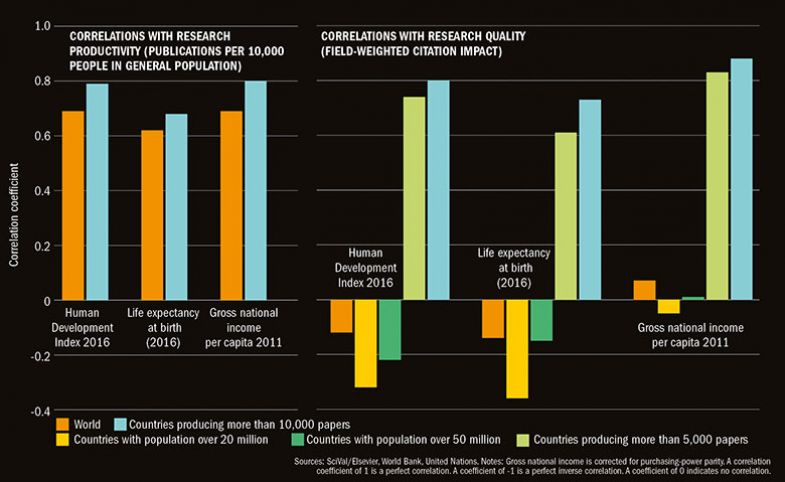
Each country’s history and circumstances make it difficult to draw general conclusions about the precise way in which higher education and economic success interact. For instance, Valero notes that in many Asian countries, whose higher education sectors developed much later than those of Western Europe and the US, the economic reward offered by universities only applies significantly post-1990 – but it is stronger than the global average. In that region, a 10 per cent increase in the number of universities within a region equates to GDP growth of about 0.9 per cent.
But there are also enormous differences within Asia. The case of India, for instance, marks a stark contrast with that of China. While the latter is widely expected to reap the economic rewards of its enormous expenditure on higher education over the past 20 years, the vast majority of India’s many universities are still low quality by international standards, and economically unproductive.
“Sadly, universities in India have not, to a large extent, been drivers of economic development,” says Raj Kumar, vice-chancellor of O. P. Jindal Global University, a private institution established in 2009 in Sonipat, near Delhi. This, he notes, is in part because much of India’s best research is done outside universities, in government entities such as the Indian Space Research Organisation and the Council of Scientific and Industrial Research.
“Universities are not yet recognised to be important partners in economic growth of the country,” he says. “Promotion of free trade, removing regulatory barriers…These are far more relevant and critical for economic growth and development than what is going on in universities.”

In contrast to India – as well as to many developed countries, such as France and Germany – a great deal of the UK’s research is carried out in universities. That is despite the fact that when the country’s industrial and economic explosion occurred in the late 18th century, there were only two universities in England and four in Scotland. Richard Jones, professor of physics at the University of Sheffield, notes that “in most advanced countries, most of the time, research done in universities has formed only a rather small part of the total amount of scientific research. Most research has been done in companies, and in various types of state-supported laboratories doing ‘strategic science’, supported by government departments”. Germany, for instance, spent E160 (£140) per capita on non-HE government research in 2015, compared with the UK’s E46, according to Jones, who is chair of the technical advisory group for the knowledge exchange framework, the UK government’s embryonic programme to assess universities’ knowledge transfer activities, based on the view of former universities minister Jo Johnson that UK institutions “must do more” to strengthen their links with business and industry.
From the 1980s, successive UK governments “ran down” national laboratories “as a matter of policy”, Jones continues. Combined with a relative decline in the country’s industrial research base, this has left the university research sector “disproportionately important in the overall UK research system”. In turn, this has increased pressure on university researchers to deliver economic benefits, “all the more pressing in the face of [the] continuing relative stagnation of our economy”.
But Johnson was not the first policymaker to worry about the UK’s perceived inability to extract a proportionate economic pay-off from the enormous research strength of its university sector. That was why impact was introduced to the 2014 research excellence framework. While impact does not have to be economic, a desire for greater economic impact was the germ of the impact agenda, and its driving political force. Former universities and science minister David Willetts revealed in his recent book, A University Education, that “when I negotiated with the Treasury in the summer of 2010 for cash protection for the science budget, one of their conditions was that we should go ahead with the impact exercise within the REF”.
Like Australia and a number of other leading global economies, the UK has placed university research at the heart of its industrial strategy, seen as a key part of the country’s bid to remain prosperous outside the European Union. But Jones notes that business also needs to pulls its weight, pointing out that German businesses spent E727 per capita on research and development in 2015, compared with the UK’s E444.

At the other end of the development scale is South Sudan, 181st out of 188 in the UN’s latest human development index. The country was only created in 2011, after decades of civil war in Sudan. Its universities are also young: the oldest, the University of Juba, was founded in 1977. It now has five public institutions and 13 private ones but, according to Kuyok Abol Kuyok, an associate professor in the College of Education at Juba, the sector has always been afflicted by poor levels of funding and a lack of autonomy.
About 20,000 students are enrolled in higher education in South Sudan – half of them at Juba – and a similar number abroad, mostly in other East African countries, such as Sudan and Egypt. But the system is still fragile after South Sudan itself erupted into civil war in late 2013 – which, according to Kuyok, had “a colossal negative impact on oil production and therefore the economy”. As a result, some university students and lecturers have fled the country and some universities have relocated, while others have closed.
The country’s government recognises the need to develop a quality education system to upskill its workforce and develop its economy, Kuyok says. Moreover, higher education in the country is still expanding, with new universities being created. However, this is not as a result of government action; in fact, higher education remains something of a policy vacuum, according to Kuyok.
“The minuscule percentage of public funding for universities underscores this perception,” he says. “The lack of government policy, a result of the war deflecting its attention and resources to other existential matters, has created a situation in which the expansion in higher education is simply governed by demand.” That demand comes from a huge young population, with a “considerable [thirst] for skills”.
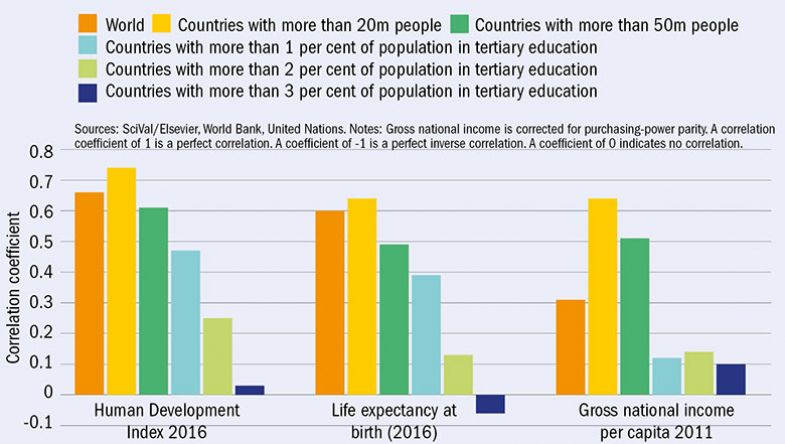
This demand only intensified further after the recent devaluation of the South Sudanese currency. This meant that even wealthy parents, who had previously sent their children abroad to university, were forced to bring them home, no longer able to afford international student fees. But Kuyok sees a silver lining to this cloud because it could lessen the country’s brain drain, given that many students who go abroad never return.
The lack of government attention given to universities could also be a blessing in disguise, he believes: “It offers freedom for private as well as public universities to design courses and programmes that are popular with the students and demanded by the students and, of course, the market,” he says. “These are essential ingredients for socio-economic development.”
There may be no one set of rules for a country to follow in order to build a strong economy, but it is clear that universities cannot work miracles in a vacuum. For the best chance of success, Kuyok believes that South Sudan will need to nurture its private industry alongside its higher education sector.
Sheffield’s Jones makes a similar prescription for the UK.
“Should universities regard it as a central part of their role to contribute to boosting the economy in their region and nationally?” he asks. “Very much so: they already do a lot, but more could and should be done. But should governments rely exclusively on universities to boost economic growth? No, universities can only contribute as part of a wider innovation system that involves strong private sector R&D and other translational and strategic research institutes.”
Recent UK policy, in Jones’ estimation, has focused too much on the “supply side of innovation” – universities – and not enough on the demand side – industry.
“Governments need to pay much more attention to their role in creating the demand for research and innovation,” he concludes.
Remedial rankings: ‘developing nations need a meaningful league table’
We all know that there is not a reputable journal on earth that would publish a set of average values without an associated estimate of their variance.
Yet the fact is that people just love lists, and this is as true in higher education as it is everywhere else. The same academics who would instantly reject such flawed analyses in their own disciplines boast or moan about their institution’s place in Global University rankings. News reporting in the internet age relies heavily on converting complex, multifactorial problems into simple linear scales of good versus bad. And politicians often see value and accountability in similar terms. So if their domestic universities score poorly by supposed international standards, that is taken as an indication that they are not doing anything useful for the nation.
I am the vice-chancellor of a university that cannot be found even at the foot of most world rankings. Now stop for a moment and think: just how much do the world’s most prestigious universities have in common with those facing the biggest challenges? What can you measure that enables you to meaningfully compare such vastly different organisations? No, let me rephrase that: what can you measure that enables you to constructively compare such vastly different organisations? Because surely there is only value in the obsession with league tables if it helps improve standards.
A quick glance at the tables reveals the obvious: those of us kicking a ball around in the Sunday pub league are all from developing countries. But, here, education is arguably more important than anywhere on Earth. In such financially challenged countries it is vital to generate a pool of graduates with the ability to create employment opportunities, revenue and, most importantly, tax income for government to invest in infrastructure, including universities. This is the virtuous circle called development.
In these extreme conditions, arguably the best universities are the ones that do most with least. If you want a tangible example, my own university here in Papua New Guinea has just started to offer the nation’s first degree in sustainable tropical forestry, with the intention of producing graduates who can help to curtail the 80 per cent of logging here that is illegal.
University league tables overwhelmingly focus on elite establishments, without any thought for the consequences for those who are less fortunate. I would argue that, on a global scale, universities in developing countries have the potential to make impacts that are just as significant as the contributions of Oxbridge and the Ivy League. But there is little we can do to climb a league table based on criteria designed to assess a completely different beast.
The failure of university league tables to be relevant to institutions in developing countries is a missed opportunity. Many in the development industry would argue that it is better to invest in the education of elite students from the world’s poorest countries by sending them to premier league universities. But this is an example of boomerang aid. Funds that desperately need investing in under-resourced universities flow straight back to rich donor nations. All too often, so do the graduates who have benefited from being educated abroad.
There are now so many variants of university rankings, surely it is time for a meaningful league table that encourages and supports universities in developing countries. If such rankings included data on how little funding we receive, perhaps we could shame national governments and aid agencies into better supporting us. If we could identify which institutions are able to function on a shoestring and still help drive the advancement of their nations, we may discover how they manage to achieve this, and be in a position to share best practice.
Unfortunately, the current crude league tables actually make things worse. They provide politicians with a stick to beat us with. Unsurprisingly, ministers have lots of competing demands on their limited resources, and when a country is poor, any excuse not to fund something is never passed up. A helpful league table could incorporate data on returns on investment, and help educate politicians in developing countries about the value of their universities.
John Warren is vice-chancellor of the Papua New Guinea University of Natural Resources and Environment.
POSTSCRIPT:
Print headline: Engines of prosperity?
Register to continue
Why register?
- Registration is free and only takes a moment
- Once registered, you can read 3 articles a month
- Sign up for our newsletter
Subscribe
Or subscribe for unlimited access to:
- Unlimited access to news, views, insights & reviews
- Digital editions
- Digital access to THE’s university and college rankings analysis
Already registered or a current subscriber? Login
